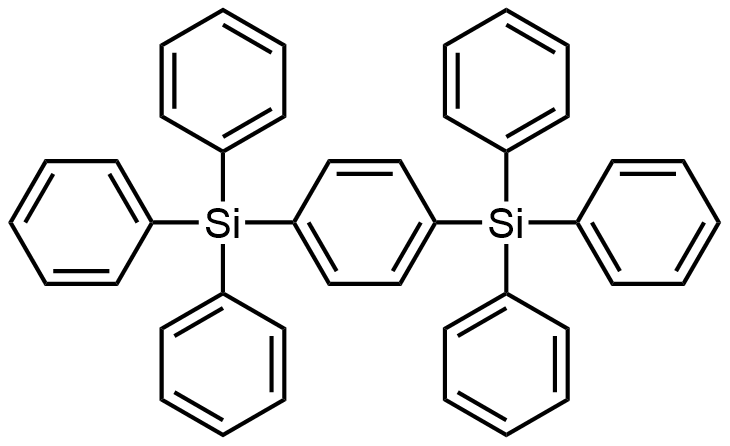The content on our website is provided solely for general informational purposes. It should not be considered, nor is it intended to provide advice or recommendations for the purchase, sale, or trade of any products or services. Importantly, the information presented does not constitute an offer to sell or a solicitation of an offer to buy any product.
Please be aware that the availability of our products may vary across different markets due to regulatory restrictions or other considerations. Consequently, not all products or services may be available in your region or country. For specific inquiries regarding the availability and pricing of any product, please contact us at sales@noctiluca.eu.
General information
-
Name:
UGH2
-
Full name:
1,4-Bis(triphenylsilyl)benzene
-
CAS number:
40491-34-7; 18856-08-1
-
Chemical formula:
C42H34Si2
-
Molecular weight:
594.89 g/mol
-
Absorption:
λmax = 265 nm in DCM
-
Photoluminescence:
λmax = 298 nm in DCM
-
HOMO/LUMO:
HOMO = 7.2 eV, LUMO = 2.8 eV
-
Synonyms:
UGH-2, 1,4-Phenylenebis(triphenylsilane)
-
Classification:
Organic light-emitting diodes, Hole blocking layer materials (HBL), TADF materials, PHOLED materials, TADF materials
-
Purity:
Sublimed: >99.0% (HPLC)
-
Melting point:
TGA: 350 - 352 °C
-
Appearance:
White powder/crystals
Explore UGH2: The Keystone for Advanced OLED Technology
UGH2, known scientifically as 1,4-Bis(triphenylsilyl)benzene, with CAS numbers 40491-34-7 and 18856-08-1, emerges as a critical compound in the OLED materials market. This compound, boasting a chemical formula of C42H34Si2, is integral to the fabrication of organic light-emitting diodes (OLEDs), serving across a spectrum of applications including Hole Blocking Layer (HBL) materials, Thermally Activated Delayed Fluorescence (TADF) materials, and Phosphorescent OLED materials. With its sublimation purity exceeding 99.0% as verified by HPLC, UGH2 is positioned as a premier choice for enhancing the efficiency, stability, and color fidelity of OLED devices.
The Molecular Structure and Properties of UGH2
The unique molecular structure of UGH2, characterized by the two triphenylsilyl groups attached to a central benzene ring, optimizes electronic interactions within OLED devices. This configuration promotes efficient charge carrier mobility and effective hole blocking, essential for the stability and luminous efficacy of OLEDs. The energy levels of UGH2, with a HOMO of 7.2 eV and a LUMO of 2.8 eV, facilitate seamless integration into OLED architectures, contributing to devices with improved brightness and energy efficiency.
Key Features of UGH2
- Unmatched Hole Blocking Efficiency: UGH2 distinguishes itself with unparalleled hole blocking capabilities, crucial for optimizing the electrical characteristics of OLED devices. This efficiency not only reduces power leakage across the device but also significantly enhances the electron-hole recombination efficiency, leading to improved device performance. By effectively preventing hole transport to undesired layers, UGH2 contributes to the reduction of power consumption and boosts the operational lifespan of OLED displays, making it a cornerstone for energy-efficient OLED technology.
- Versatility in OLED Applications: The molecular design of UGH2 allows for its seamless integration into a variety of OLED structures, demonstrating its flexibility across a broad spectrum of applications. From Electron Transport Layers (ETL) to Hole Blocking Layers (HBL) and even as a component in Thermally Activated Delayed Fluorescence (TADF) materials, UGH2’s compatibility with these diverse roles underscores its vital contribution to the advancement of OLED technologies. Its adaptability facilitates the development of innovative OLED products, ranging from high-definition displays to energy-saving lighting solutions, showcasing its critical role in pushing the boundaries of organic electronics.
- Superior Purity and Performance: With a sublimation purity exceeding 99.0%, UGH2 sets the standard for material quality in the OLED sector. This exceptional level of purity, verified through rigorous High-Performance Liquid Chromatography (HPLC) analysis, is imperative for achieving high- performance OLED devices. The minimization of impurities ensures that UGH2 can deliver consistent and reliable performance, contributing to the overall device efficiency and longevity. This purity not only enhances the optical and electrical properties of OLED displays but also contributes to the reduction of manufacturing complexities, positioning UGH2 as a key material in the production of superior OLED technologies.
The Role of UGH2 in Advanced OLEDs
UGH2 plays an instrumental role in the advancement of OLED technology, facilitating the creation of displays that marry aesthetic excellence with environmental efficiency. As a versatile component in both TADF and phosphorescent materials, UGH2 enhances light emission processes, leading to OLED displays characterized by their superior brightness, color saturation, and energy-saving features. This contribution is crucial for the ongoing innovation and sustainability of OLED technology, enabling the development of displays that are not only more visually appealing but also more durable and energy-efficient.
Conclusion
UGH2 exemplifies Noctiluca’s dedication to advancing OLED material science, providing state-of-the-art solutions to meet the dynamic requirements of the OLED industry. Our commitment to supplying high-quality UGH2, combined with our comprehensive services in chemical manufacturing and research, establishes Noctiluca as a leading figure in the OLED materials market. By fostering the development of OLED technologies with superior materials like UGH2, Noctiluca is at the forefront of driving the future of display technology, ensuring our partners achieve unparalleled success in device performance, visual quality, and sustainability.
